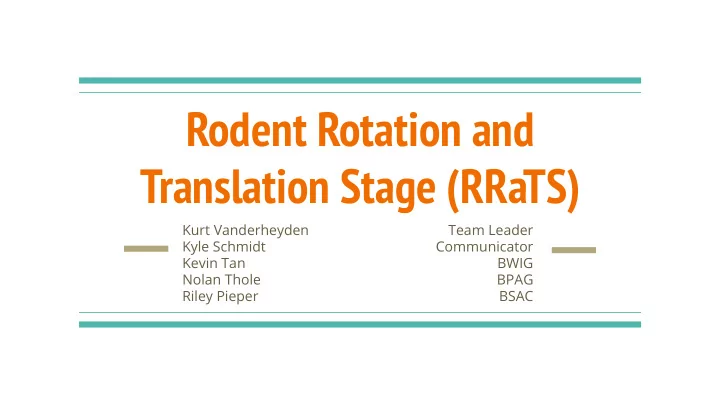

Rodent Rotation and Translation Stage (RRaTS) Kurt Vanderheyden Team Leader Kyle Schmidt Communicator Kevin Tan BWIG Nolan Thole BPAG Riley Pieper BSAC
Problem Statement Imaging of photoreceptors in rats requires precise alignment ● Must develop a stage with translational and rotational capabilities ● Translational for alignment ○ Rotational for imaging all parts of the eye ○ Must keep eye at the intersection of the axes ● Open top to allow easy access to the rodent ●
Ocular Imaging Reasons for Imaging rats: ● Glaucoma ○ Damage to the optic nerve ■ High pressure in eye ■ Macular degeneration ○ Macula is damaged and central vision loss ■ Wet= growth of abnormal blood vessels ■ Dry= part of macula gets thinner and protein ■ clumps develop Cell replacement therapy ○ Gene therapy ○
Imaging Subjects Average rat weighs 250-500 g ● Average length 17-21 cm ● Rats used in lab because: ● Frequent reproduction ○ Genetic purity ○ Similarity to human biology ○
Current Lab Setup Current alignment stage gets in the way ● Lacks adjustability for working distance ● Currently 10mm, optimally work up to >100mm ○ Live feedback from computer for alignment ●
Competing Solutions Bioptigen’s rodent aligning system ● Two degrees of rotation: roll and yaw ● 1 degree of translation inside the rotational axes ● 3 degrees of translation outside the rotational axes ● Why design a new solution? ● Lacking pitch rotation ○ Translation within the rotational axes is required for ○ positioning the eye in the center of rotational axes No longer sold ○
Previous Design Team’s Solution Provided 5 degrees of freedom ● Struggles ● Failed to keep eye in center of axes ○ Difficult to sanitize ○ Poor choice of materials ○
Problem Statement - Refined Imaging of photoreceptors in rats requires precise alignment ● Must develop a stage with translational and rotational capabilities ● Translational for alignment ○ Rotational for imaging all parts of the eye ○ Must keep eye at the intersection of the axes ● Open top to allow easy access to the rodent ●
Product Design Specifications 5 Degrees of Freedom (minimum) ● 2 Rotational: pitch yaw ○ 3 Translational: x y z ○ Adjustment Precision: ● Eye Alignment: 100 microns ○ Rotation: 2° ○ Optimal Resolution: 500 microns FOV ○ Interchangeable Sample Holder: Flexibility ● Smooth Surfaces: Sterilizability ● Budget: $350 ●
Design Alternatives Considered - Bowls 6 Degrees of Freedom ● Friction-Based Adjustment ● Rotational Knobs ○ Spinning Plate ○ Translating Rails - Internal Translation ○ Mount Sample Holder on Stage ●
Design Alternatives Considered - Pizza 5 degrees of freedom ● Rotational Adjustment - Friction ● Cylinder - Pitch ○ Pivot - Yaw ○ Internal Translation ● Precise Dial Alignment ○ Travel Along Threaded Rods ○
Design Alternatives Considered - Field Goal 6 degrees of freedom ● External translation ● Telescoping raising/lowering ○ Rotational adjustment - Thumb screw ● Pitch and Yaw ○ Internal translation ● fine knob adjustment ○ Telescoping raising/lowering ○
Design Matrix Criteria Design 1: Design 2: Design 3: Bowls Pizza Field Goal Ease of Adjustment (20) 3 5 3 Rotational Freedom (18) 5 4 3 Translational Freedom (15) 3 4 2 Ease of Fabrication (12) 3 2 5 Sterilizability (12) 4 3 3 Strength (8) 2 4 2 Safety (5) 4 5 4 Simplicity (5) 3 2 5 Cost (5) 3 1 5 Total (100) 69 72.8 65.2
Future Work Optimize the Pizza Design (ongoing) ● Component to Guide Pupil Alignment? ○ Integration of Design with Imaging System (Cart?) ○ Develop Fabrication Plan for Pizza Design ● Determine Necessary Materials for Prototype ● Conduct Testing on Prototype ● Rotational Precision ○ Translational Precision (Accuracy of Pupil Alignment) ○
Acknowledgements Prof. Jeremy Rogers ● Dr. Ben Sajdak ● Prof. Aaron Suminski ●
References E. Ades, “Species Specific Information: Rat,” Johns Hopkins University, 11-Mar-2009. [Online]. Available: ● http://web.jhu.edu/animalcare/procedures/rat.html#normative. [Accessed: 01-Oct-2019]. wiseGEEK. (2019). Why are Rats Used in Animal Testing? (with pictures). [online] Available at: ● https://www.wisegeek.com/why-are-rats-used-in-animal-testing.htm [Accessed 25 Sep. 2019]. Medicalxpress.com. (2019). Researchers uncover evidence of restored vision in rats following cell transplant. ● [online] Available at: https://medicalxpress.com/news/2018-11-cell-transplant-vision-rats.html [Accessed 25 Sep. 2019]. G. Musser. (2018, Oct. 10). Rat [Online]. Available: https://www.britannica.com/animal/rat ● Mayo Clinic. (2019). Glaucoma - Symptoms and causes . [online] Available at: ● https://www.mayoclinic.org/diseases-conditions/glaucoma/symptoms-causes/syc-20372839 [Accessed 2 Oct. 2019]. American Academy of Ophthalmology. (2019). What Is Macular Degeneration? . [online] Available at: ● https://www.aao.org/eye-health/diseases/amd-macular-degeneration [Accessed 2 Oct. 2019].
Recommend
More recommend